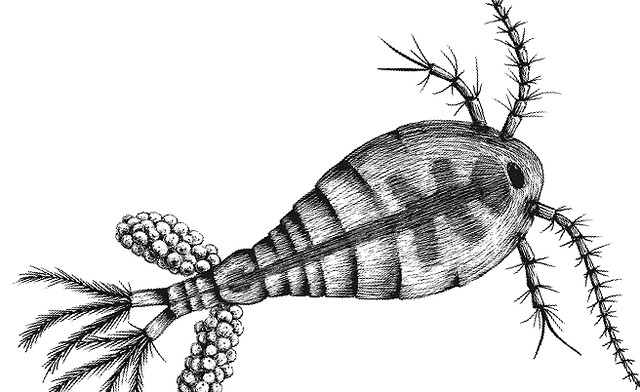Copepods (/ˈkoʊpɪpɒd/; meaning “oar-feet”) are a group of small crustaceans found in the sea and nearly everyfreshwater habitat. Some species are planktonic (drifting in sea waters), some are benthic (living on the ocean floor), and some continental species may live in limno-terrestrial habitats and other wet terrestrial places, such as swamps, under leaf fall in wet forests, bogs, springs, ephemeral ponds and puddles, damp moss, or water-filled recesses (phytotelmata) of plants such as bromeliads and pitcher plants. Many live underground in marine and freshwater caves, sinkholes, or stream beds. Copepods are sometimes used as bio indicators.
Copepods vary considerably, but can typically be 1 to 2 millimetres (0.04 to 0.08 in) long, with a teardrop-shaped body and large antennae. Although like othercrustaceans they have an armoured exoskeleton, they are so small that in most species this thin armour, and the entire body, is almost totally transparent. Some polar copepods reach 1 centimetre (0.39 in). Most copepods have a single median compound eye, usually bright red and in the centre of the transparent head; subterranean species may be eyeless. Like other crustaceans, copepods possess two pairs of antennae; the first pair are often long and conspicuous.
Copepods typically have a short, cylindrical body, with a rounded or beaked head. The head is fused with the first one or two thoracic segments, while the remainder of the thorax has three to five segments, each with limbs. The first pair of thoracic appendages are modified to form maxillipeds, which assist in feeding. The abdomen is typically narrower than the thorax, and contains five segments without any appendages, except for some tail-like “rami” at the tip.[4]
Because of their small size, copepods have no need of any heart or circulatory system (the members of the order Calanoida have a heart but no blood vessels), and most also lack gills. Instead they absorb oxygen directly into their bodies. Their excretory system consists of maxillary glands.
(From Wikipedia, February 2015)




